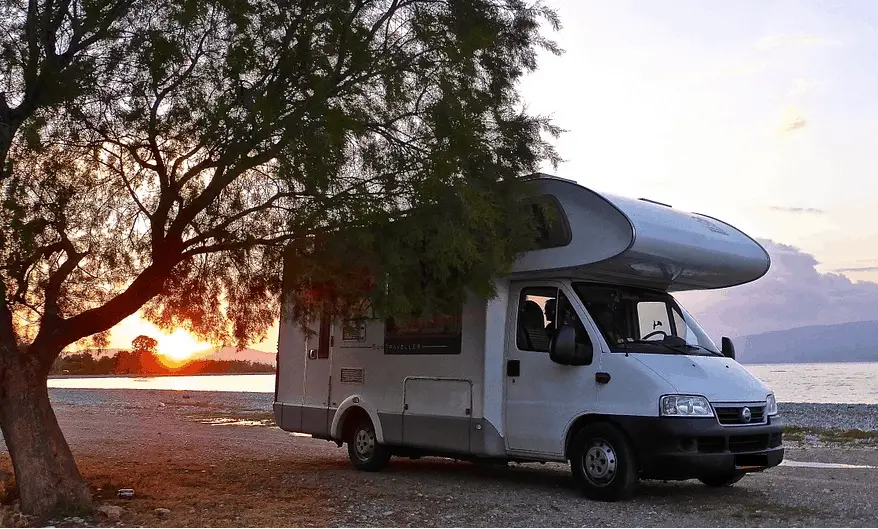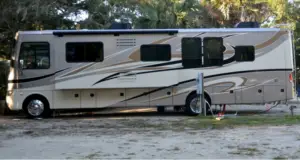In this article, I will be covering an important topic for new RVers and that is, how long does water stay fresh in a RV water tank?
Living in a RV means you need fresh water for different activities like drinking, washing utensils and bathing and for toilet. When it comes to drinking water, one has to be more cautious as contaminated water can be bad. You know what i mean.
Sure, we do use fresh water tanks for storing the water needed for drinking but not all do that. Some people avoid storing the water ; mostly because of the fact that water may not be good, it will catch up bacteria and algae may grow.
They prefer camping at campgrounds which provide direct hookup for fresh water. That’s kind of a relief from all the issues associated with water storage systems.
In case, if you are one of those who use fresh water tank, and if you are relatively new to the RV life then you will have this questions.
How long do you keep the fresh water stored in a tank?
Well, the answer to this question is:
Fresh water in RV tank on an average remains drinkable until 2 weeks and a lot depends on quality of the water and tank’s condition. Chlorinated water in a properly sanitized water tank will last longer if the outside temperature isn’t too high. Also, fully filled tightly capped tank with a chlorinated water will last much longer. A good rule of thumb however, is to replace the water as soon as it becomes 2 weeks old.
Water for other usages like washing utensils, clothes and bathing however may be stored for longer times like a month or more but remember you will have a common tank.
Thus, its upto you how you want to go ahead with this. Drinking water can also be carried in bigger bottles depending on your need.
Having said above, it totally depends on the quality of water that you will use, and also the conditions of your fresh water tank. That is, how often you clean your tanks, super sanitize of your RV tank and other elements like the hose used to deliver the fresh water.
Lets talk about why some RVers use the water for much longer.
Its very common for campers to say that they use the water for many more weeks. In fact, you too can do that but I say why do this adventure when you can simply replace the water.
In most cases, nothing will happen unless it was a very bad quality water or the temperature was furiously high like sometimes in California. A loosely capped tank, not properly sanitized, bugs getting into the tank, things like this can result in spoiling the water or resulting in bad smell.
Another popular example that we see is of ships that sail for months and months. They carry the water when they start the journey and use the same water throughout. So, its possible to use the water for much longer. Water in its purest form will last much loner.
The Problem
The only problem is, you are storing it inside a artificial tank that could be plastic and with high temperature that may not be a good idea to keep it longer under that circumstances.
Adding few ounces of chlorine improves the quality of the water and that will not turn green faster. City water or municipal water has chlorine added to it where as campground water may not be treated like that.
Rule of thumb
So, why not just replace and follow the rule of thumb? That is why i said and many other RVers follow the 2 weeks rule. Yes, if you have filled the take to the top then there wont be much air inside it and it will last longer.
It depends on how the tank is sealed from outside and also on the outside temperature. During hot temperature times the bacteria growth can be easy and the water may not remain good for drinking purpose.
Why avoid storing water for long time
The main reason why you should avoid long storage period is because bacteria can grow inside the water depending on the conditions and that may not be good for health. A drinking water need to remain fresh.
If you camp often and go out like every week or so, then it could be easy for you as the water will be used almost continuously. A full timer infact will need less of draining away with water as they continuously use the water.
If you are one of those who go camping out once in month, then it would make sense to drain out or dump the water every time you come back from the camping trip.
This is about draining the water from the fresh water tank every month or so.
What about cleaning the water tank, how often you need to do that. A super sanitization should be carried out once a year or twice depending on your usage.
How do you know the water isn’t fresh and usable
The 2 weeks timeline that we saw above is ideal but sometimes the water may go bad much earlier as well. This will happen mostly in all the scenarios that we already discussed like.
- Water was filled from a bad source that was not properly chlorinated or treated.
- The fresh water tank wasn’t sanitized for many months and was in bad shape.
- The tank wasn’t closed tightly.
- Or the most common factor could be bad weather. A high temperature and humid weather can result in spoiling the water faster.
Any of these factors can result in below that should signal to you that its time to drain the tanks and refill it.
- Foul smelling water.
- Bad tasting water that isn’t how it tastes usually.
- Color changes like slightly light greenish
- The water liens can also clog signaling something is wrong with the water.
What’s the best water sources for your RV water drinking needs?
City water or municipal water, which is treated with chlorine is the best source of water for your drinking needs in RV. Campground water from well may not be great as it may not have been treated properly for high standards.
Understanding the water system and tanks in RV
If you are new to RV’s then you should know about this. A motorhome or travel trailer not only stores water for drinking, bathing but also has to store the waste water from sink, bathroom and also from toilet. Knowing about RV water tank capacity is key in camping.
In fact, there are two separate tanks used for the water holding. These tanks are know as holding tanks. A grey tank stores the water sent from the sink and bathroom. Where as a black water tank holds the waste sent from the toilet.
Like, how a fresh water tank is supposed to be cleaned and taken care of, the other two tanks also need to be cleaned and you need to dump them regularly. As other wise there will be possibility of overflowing and chances of malfunctioning of the sensors inside them.
Next thing is about the hose, the hose you use for drinking water tanks need to be specially designed one. Its mostly white in color and for grey and black tank a green colored is to be sued.
Interchanging green instead of white will not be good as they are specially designed and the water may taste bad with the green hose (due to the material used for making it).
How to keep the water fresh in RV
Even though we saw that keeping the water inside rv fresh water tanks can remain fresh for like 2 weeks, this may not always turn out to be true. It can go either ways. It totally depends on the conditions of your fresh water tank.
A tank that has not been cleaned for years will mean the bacteria will grow very easily inside it and more chances that the water will taste bad while drinking.
Knowing how much water we need for our use can also be helpful as you wont overfill the tanks. Here is a article that i had posted about RV water usage, it includes more details about RV shower usage but it will definitely help.
So, what do you do to keep the water fresh every time you refill it?
You need to follow below steps, procedures to keep it fresh. Lets see those practices,
If you are a new RVer then i am sure you had this question. Can i add bleach to my RVs fresh water tank? Yes, you can add bleach to a fresh water tank in the RV. That’s exactly next step is about. Do watch the video to get more details on this.
1. Sanitize the fresh water tank properly and periodically.
You can do this by using bleach. You need to add bleach to the tanks depending on the size of the fresh water tank.
A 50 gallon of tank will need around a 5 gallons of bleach solution (bleach added to water).
Similarly, a 100 gallons of water tanks will need around 8-10 gallons of bleach mixed water.
- You need to add the bleach mixed water to the tank and then run the faucets so that water flows through the hose to the faucet.
- Continue doing this until you smell bleach at faucets.
- After doing this step make sure you keep the tanks empty for a night and next, fill the fresh water tank with fresh water and drain the water again.
- You need to continue doing this until the bleach smell goes always at the faucets.
Doing this will sanitize your fresh water tank to great extent.
Is there a way to sanitize m RV fresh water tank without bleach? Well, yes you can sanitize a fresh water tank without bleach but by using backing soda or even vinegar.
Not much interested in using homemade solutions like this? Worry not ! The RV market is huge and there are several products that are available for RV fresh water sanitization like the below one by Camco.

2. Use water that is good in quality
Well, that’s no brainier. If you fill the fresh water tanks with water that itself was not of good quality then don’t expect it to remain good.
Not all campgrounds supply water of same quality. So, make sure you know what quality water you are refiling in the first place.
3. Use correct hose
Using correct hose for fresh water tank supply is necessary. Use the white one and do not interchange it with green one. Using green colored may give bad taste and you definitely want to avoid that.
4. Keep the holding tanks cleaned as well
Well, there may not be direct contact between fresh and holding tanks. But, keeping you holding tanks well sealed can keep the trailer or motorhome smell free and will keep the piping systems intact and fresh.
The other day when i was at a campground, the class c RV owner that i talked to was emphasizing about how important it is to maintain the holding tanks for overall cleanliness in motorhomes.
How often to sanitize the RV fresh water tank
So, you are an RVer who doesn’t consume water from the tank? Then i am sure you are wondering whether you should sanitize the tank at all and if yes, how often?
No matter how much you use your RVs fresh water tank, its necessary that you sanitize it at least once every 6 months. This is necessary even if you don’t drink water from the tank. It doesn’t matter if you don’t use it at all or use it less often.
Also, if you see that the water is getting bad too soon or you get odor in the water then sanitize the tank as soon as possible. Apart from filling water from proper sources, sanitizing the tank is the most important thing to do to keep the water fresh for longer time.
Not sanitizing the tank will lead to bacteria growth in the water, consuming which can result in health issues.
Algae problem in fresh water tanks
Algae inside a RV fresh water tank is a common problem many people face. They come to know about it only after they taste the water and it turns out to be odd. Its that green patch inside the tank that can in-fact make the water so bad that it can be harmful for your body.
As we already saw above that the water be not stored inside he fresh water tanks for more than 2 weeks, the more time you keep it stored more is the chance of growing algae.
The water stored inside the fresh water without any movement of getting drained through faucets means there are chances that algae will start their growth.
The main reason for the growth is sunlight. But, with fresh water tanks the sunlight may not be there but with high temperatures and heat the growth harbors.
The problem of algae may not come to your notice so easily. Until you get that smell in the water and that could be late as you may have already drank the water multiple times. That’s the main reason why the water should not be there for long.
Unless you are continuously using the water, chances are pretty high that the growth of algae will increase.
Also, note that the growth may not happen all the time just because the water stood there for more time. The conditions should become favorable for the algae growth, which is definitely not in your hands.
Also, it does not matter if you own a luxurious class A motorhome of a smaller pop up camper or tent trailer. To keep the water fresh, you need to take the efforts in cleaning the tank.
The growth is normally seen in high temperature conditions. So how do you get rid of algae in the fresh water tank then? Lets see what can be done below,
Getting rid of algae in fresh water tank
The steps in getting rid of algae are nothing other than the ones that we discussed above. You need to super sanitize your RV with bleach.
Adding bleach in water and then flushing or draining the tanks fully. Repeating the process until the bleach smell gets away. These same steps you need to do periodically so that the algae do not come again.
You also get testers for checking if there is any algae growth inside the fresh water. You can check at retailers like Walmart for same.
Algae in Hot water tanks
So, can the algae grow inside the hot water tanks too? well, the answer to this is Yes. They can. Infact they can survive at higher temperatures. So how do you manage that ?
You also need to sanitize the hot water tanks before putting the RV for storage when the season ends.
You need to follow the steps and sanitize the RV hot water tanks system. I wont be covering that topic as it itself is a big topic and will need proper details for you to follow.
Can water filter help in case of algae
The inline water filter may help reduce bacteria and algae but will not completely remove them.
When you go for the filter make sure you read the product description properly and understand what exactly will it be effective in.
Having said this, using filter cannot be a permanent solution. But, if you feel your RV is old enough then having a filter like Camco 40043 TastePURE Water Filter (amazon link) can be a good thing to do.
Also if you feel, no matter how much you clean the tanks algae and bacteria keep coming then getting a filter installed is a way to go.
It kind of gives you that extra safety and you definitely don’t want that health issue due to bad water.
Sludge and mold inside the RV fresh water tanks
Ever had this awful experience with your fresh water tanks? If yes, then you know how it feels when the season is just starting and you have this one of the terrible problems.
Keeping the RV for storage without winterizing it properly (not fully draining the fresh water tank) can result in this mold problems.
It could be very little water, infact you may not even feel that the was water left and then this happens. Algae can start forming with very little water, higher temperature or warmness in water or light. It can lead to sludge and mold.
This problem too can be resolved by rinsing the tank with chlorine or bleach and repeating the process until its all clear. The better option in such problems is to be always preventive and make sure winterizing is done with more better care.
In Conclusion
Fresh water tanks need to be properly sanitized regularly and the quality of water need to be good if you want to use the fresh water tank without any issues. Water can remain fresh and usable for longer period if you follow all the basics like filling water from better sources, sanitizing the tank and emptying it regularly.





